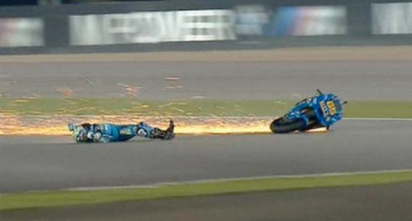More information
Main author
Vangi, D.
Co-Authors
Virga, A.; Zaffelli, J.
Type of media
Publication type
Lecture
Publication year
2013
Publisher
22. EVU Conference, Florence
Citation
Vangi, D.: Experimental analysis of post-accident motion of motorcyclists
 A common feature in road accidents is the total loss of control of the vehicle. Dealing with motorcycle accidents this means that the rider usually abandons the vehicle and follows a different trajectory. From the point in which the control loss happens and the point in which the body is at rest, usually the latter bounces, rolls and slides on surfaces that can be asphalt, grass or gravel. In technical literature can be rather easily found data regarding coefficients of friction of sliding motorcycles (with or without fairing) as in, or projected pedestrians. Little can be found about sliding motorcyclists: in [2] coefficients of friction for a motorcyclist wearing normal clothes and sliding on asphalt or grass can be found. The aim of this work is the characterisation of different surfaces as regards the behaviour of motorcycle riders after having lost the control of their vehicles, aiming at reconstructing road accidents and predict sliding distance in case of a fall. The experimental activity here described, carried out at different sites, on different surfaces and with different speeds, allows the prediction of sliding distances from speeds up to 240 km/h, typical of road racing (like Isle of Man TT) and circuit racing. Thus the activity here presented can yield useful data for the purpose of accident reconstruction and also for the design of run-off areas along roads and racing circuits.
A common feature in road accidents is the total loss of control of the vehicle. Dealing with motorcycle accidents this means that the rider usually abandons the vehicle and follows a different trajectory. From the point in which the control loss happens and the point in which the body is at rest, usually the latter bounces, rolls and slides on surfaces that can be asphalt, grass or gravel. In technical literature can be rather easily found data regarding coefficients of friction of sliding motorcycles (with or without fairing) as in, or projected pedestrians. Little can be found about sliding motorcyclists: in [2] coefficients of friction for a motorcyclist wearing normal clothes and sliding on asphalt or grass can be found. The aim of this work is the characterisation of different surfaces as regards the behaviour of motorcycle riders after having lost the control of their vehicles, aiming at reconstructing road accidents and predict sliding distance in case of a fall. The experimental activity here described, carried out at different sites, on different surfaces and with different speeds, allows the prediction of sliding distances from speeds up to 240 km/h, typical of road racing (like Isle of Man TT) and circuit racing. Thus the activity here presented can yield useful data for the purpose of accident reconstruction and also for the design of run-off areas along roads and racing circuits.